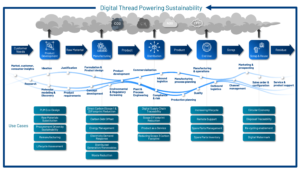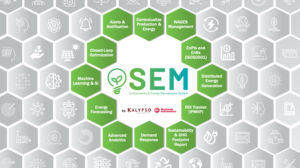The Business Value Sustainability Brings to Companies
Have you questioned the actual business value that sustainability brings to companies?
We hope that by the end of this article, you're going to think differently.
There is unequivocal evidence that the earth is warming up at an unprecedented rate. The last five years have been the warmest on record. The Greenlands and the Arctic have lost 441 billion tons of ice per year since 1993, according to NASA.
So, we know the root cause of climate change - the accumulation of greenhouse gases into the atmosphere that creates what we call the greenhouse effect. Now that we know the cause, businesses and governments are taking action and establishing Net-Zero goals. Net-zero means that organizations are making a commitment to achieve carbon neutrality to run their whole operations by a specific year and by reducing energy, reducing pollution and offsetting that through investments in environmental projects.
Emerging Regulations and Global Incentives
In addition to commitments for Net-Zero are emerging government regulations in Europe. In the EU, the SSFDR, Sustainable Finance Disclosure Regulation, was introduced to improve transparency, prevent greenwashing and ensure reporting on sustainability.
There’s also the upcoming New York Fashion Sustainability Act which would require companies to enable reporting by increasing the range and quality of their data infrastructures and altering their operational strategies to meet targets, or else risk potential penalties, public backlash and impaired investor relations.
With these regulations, the need for companies to be able to provide sustainability reports is part of compliance and market expectation with financial implications.
In addition to regulations, governments at all levels are offering incentives. The European Green Deal is a group of plans to inject almost two trillion euros into the EU economy in 2030. The US Department of Energy's focus is attracting more investments in clean air, energy and transportation.
Impact on Industry
While industry grows its sustainability agenda, global growth is slowing under increasing uncertainty. This uncertainty is mostly driven by geopolitical scenarios and their impact on the rise of energy prices.
The rise of energy prices impacts people’s homes but also means a huge impact on industry. A small to medium factory usually spends an average of $1,000,000 on electricity per year. Now can you imagine an increase of 40% only this year and a forecasted increase of at least 25% in the next year? Energy costs are driving immediate action in industry.
Companies are looking to leverage digital technology to find ways to:
- Leverage data-driven insights on energy savings opportunities
- Integrate renewables and other sources of energy more effectively
- Contextualize energy and production data together to identify creative ways to optimise production and energy consumption
- Automatic optimize energy consumption and production process through AI and Closed-Loop Control.
- Use renewables more effectively
- Develop cogeneration through thermal energy system
Overall, there’s a push in the industry to talk about the business value of sustainability. Top benefits companies can expect to see if they prioritize sustainability efforts include:
- Meet customer needs. Improve brand reputation and goodwill
- Create business efficiencies. Reduce materials and energy consumption
- Improve compliance and reporting capabilities. Permits entry into increasingly regulated markets allowing companies to be more competitive globally
- Meet investor demands. Reduce business risk, qualify for specialized-funds and increase opportunities for lower borrowing cost
- Attract and engage talent. Improve company culture and employee engagement. Job applicants are more likely to accept offers from sustainable companies
- Build new business opportunities. Increase top and bottom line from recycling and other circularity programs
Reaching Your Sustainability Goals with Digital Thread
Let’s start by rethinking sustainability powered by the digital thread.

The digital thread is a seamless flow of data and processes across the whole value chain. But what does that mean from a sustainability standpoint?
Our clients are interested in achieving productivity gains while meeting their net-zero and decarbonization goals by across the value chain. This includes:
Product Development: the digital thread can enable eco-design practices through CAD, and PLM software, facilitating the substitution of raw materials to reduce environmental impact, and designing products for remanufacturing using data analytics. Digital twins can also allow for a catalyzed iteration design process through powerful simulation capabilities. Additionally, implementing lifecycle assessment (LCA) tools can help assess and optimize the environmental performance of products throughout their lifecycle, further enhancing sustainability efforts.
Manufacturing: Digital technology, including AI and machine learning, enables the optimization of energy consumption and generation, as well as process improvements and waste reduction. By using digital tools such Kalypso Sustainability Energy Management System (SEM), companies can orchestrate their energy and emissions data, and enabling a powerful integration with production data.

Distribution: Digital technology can empower more sustainable supply chains by addressing Scope 3 emissions targets using data analytics and by enabling sustainable sourcing practices on both inbound and outbound sourcing. By prioritizing sustainability in the supply chain, companies can position themselves for long-term success in a competitive marketplace.
End Usage: Digital technology enables real-time monitoring of product performance, predictive maintenance, and optimized spare parts inventory management. This approach can extend the lifespan of products and reduce waste, as well as enable more efficient use of resources. Additionally, digital technologies such as the IoT and AI can provide insights into usage patterns and potential improvements to product design, leading to further sustainability products.
Scrap & ReUse: Digital enables circular economy principles through product disassembly, reuse or redistribution, and recycling. By using digital tools to track and optimize the disposal and recycling process, companies can reduce waste and recover valuable materials, contributing to a more sustainable approach to resource use. Additionally, digital technologies such as blockchain can support ethical disposal and recycling practices, improving transparency and accountability throughout the supply chain.
Getting Started
The first step for most companies is an assessment of the capabilities, followed by a roadmap strategy with use cases driven by business need and capabilities, and implementation solutions typically using the digital thread as a foundational enabler for the success of aggressive sustainability goals.
Prioritizing sustainability efforts can affect your organization positively across the value chain. We hope we've shed some light on the actual business value that sustainability brings to companies. Join us on the journey to sustainability!


